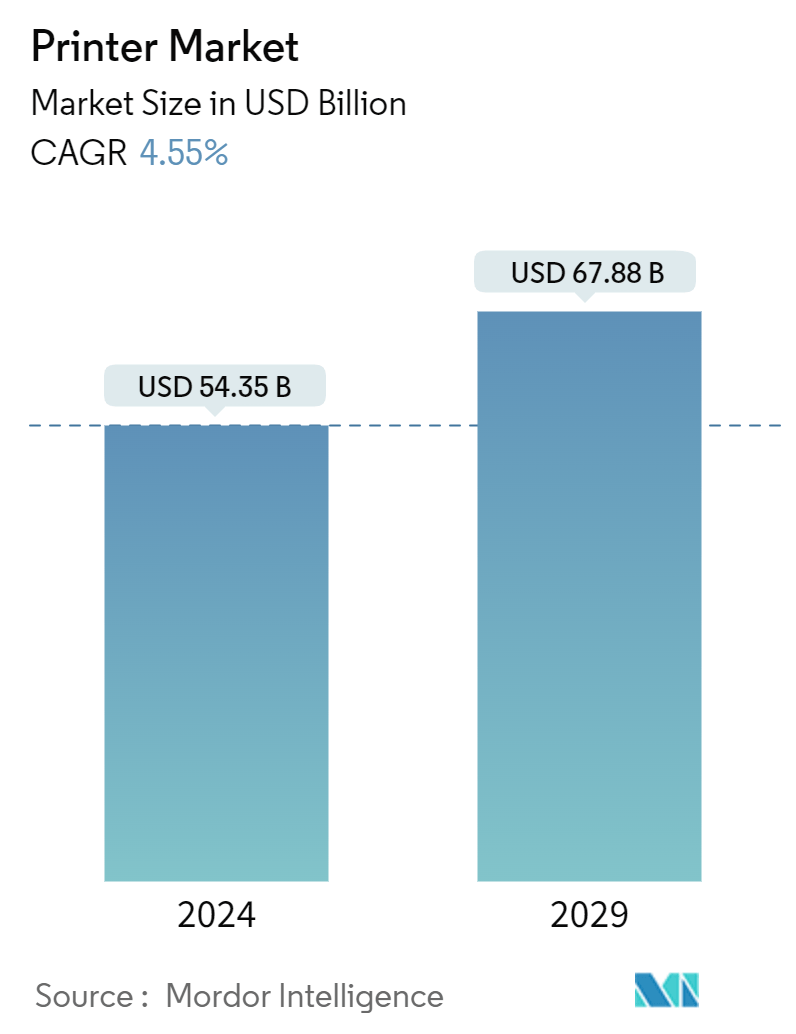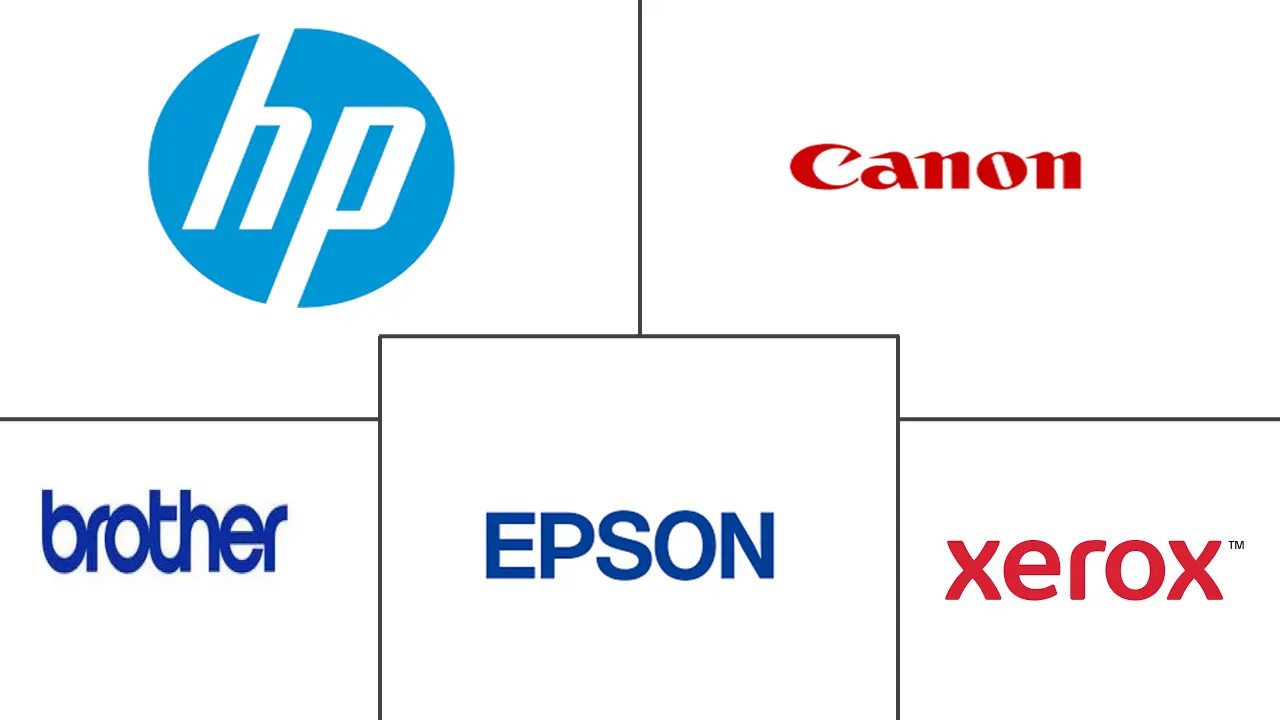Market Size of Printer Industry

| Study Period | 2019 - 2029 |
| Market Size (2024) | USD 54.35 Billion |
| Market Size (2029) | USD 67.88 Billion |
| CAGR (2024 - 2029) | 4.55 % |
| Fastest Growing Market | Asia-Pacific |
| Largest Market | North America |
Major Players
*Disclaimer: Major Players sorted in no particular order |
Printer Market Analysis
The Printer Market size is estimated at USD 54.35 billion in 2024, and is expected to reach USD 67.88 billion by 2029, growing at a CAGR of 4.55% during the forecast period (2024-2029).
- A printer is an external hardware output device that creates a physical copy of electronic information stored in a computer or another electronic device. It can reproduce documents, texts, images, or all three. The printer industry is seeing consistent expansion due to technological progress, rising demand in different industries, and strategic moves made by major companies.
- The printer market is influenced by the introduction of new technologies, the changing needs of customers, and the emergence of new printing markets. The biggest trend in the printer industry has been the growth of digital printing. The future of printing technology is expected to involve a significant focus on automating the entire printing process. Features such as automatic document feeders and automatic duplexing are becoming increasingly common in printers these days. As the demand for digital printing continues to advance, the market is expected to witness significant growth in the coming years.
- The adoption of newer printer models is driven by the desire to reduce the cost per page of printing and to simplify the process of loading new ink or toner, which has historically been challenging. The market now offers a variety of affordable and environmentally friendly ink and toner options, resulting in improved print quality, fewer ink spills, and lower print costs per page. As a result, numerous companies are making substantial investments in this technology to boost their competitiveness.
- The concept of online printing has evolved to encompass all the modern practices within the industry. It is playing a significant role in shaping the future of printing by changing how printing services are accessed, carried out, and managed. Through the utilization of technology and automation, online printers are enhancing efficiency, reducing waste, and offering cost-effective pricing. Online printing is revolutionizing the industry by promoting advancements in digital printing, online ordering systems, personalized printing, and automated processes. These substantial developments are expected to drive the market forward.
- The printing industry is witnessing a surge in growth driven by factors such as mobile printing, the rising need for color printing, packaging printing demands, market expansion for entry-level products like A4 printers, and the increasing reliance on cloud-based computing and software. Reputable online printing companies prioritize quality and uniformity by leveraging state-of-the-art printing technology and enforcing rigorous quality assurance measures. This commitment ensures that prints are of superior quality, featuring accurate colors, sharp details, and long-lasting resilience.
- Despite the obstacles presented by the COVID-19 pandemic and the surge in digital media, commercial printing is on a steady growth trajectory rather than a decline. Due to the advancements in digital printing technology, printers are now able to offer highly customized and targeted print products, meeting the unique preferences of both consumers and businesses. Furthermore, the home printer market experienced substantial growth as people stocked up on essentials during the COVID-19 outbreak, particularly with the rise of work-from-home situations.
Printer Industry Segmentation
A printer is a device that uses text and graphics as input from a computer and relocates the information to paper. The study further covers the revenue generated from the sales of printers.
The printer market is segmented by printer type, technology type, printer interface, output type, end-user application, and geography. By printer type, the market is segmented into multi-functional and standalone. By technology type, the market is divided into dot matrix printer, inkjet printer, LED printer, thermal printer, and laser printer. By printer interface, the market is divided into wired and wireless. By output type, the market is segmented into color and monochrome. By end-user application, the market is divided into residential, commercial, educational institutions, enterprises, government, and other end-user applications. By geography, the market is segmented into North America, Europe, Asia-Pacific, Latin America, and the Middle East and Africa. The market sizes and forecasts are provided in terms of value (USD) for all the above segments.
| By Printer Type | |
| Multi-functional | |
| Standalone |
| By Technology Type | |
| Dot Matrix Printer | |
| Inkjet Printer | |
| LED Printer | |
| Thermal Printer | |
| Laser Printer |
| By Printer Interface | |
| Wired | |
| Wireless |
| By Output Type | |
| Color | |
| Monochrome |
| By End-user Application | |
| Residential | |
| Commercial | |
| Educational Institutions | |
| Enterprises | |
| Government | |
| Other End-user Applications |
| Geography | |
| North America | |
| Europe | |
| Asia-Pacific | |
| Latin America | |
| Middle East and Africa |
Printer Market Size Summary
The printer market is experiencing a transformative phase driven by technological advancements and evolving consumer needs. The demand for printers is being fueled by trends such as mobile printing, increased color printing, and the growing need for packaging solutions. The market is also witnessing an expansion in entry-level products like A4 printers and a shift towards cloud-based computing and software solutions. The ecosystem of inks is evolving, with the introduction of hybrid UV/water systems and the growing use of LED inks. Despite the high cost of ink posing a challenge, the anticipated reduction in ink prices due to increased applications and economies of scale is expected to bolster market growth. Multi-functional printers are gaining traction, particularly among small and medium enterprises, due to their numerous benefits. The industry is also seeing a shift towards eco-friendly practices, with efforts to reuse, reduce, and recycle becoming more prominent.
North America stands as a significant market for printers, driven by extensive applications across various sectors such as government, education, and enterprises. The region's technological advancement facilitates the adoption of new technologies, although it also presents challenges like the decline in printed pages and the increased adoption of electronic documentation. Market players are focusing on software integration and enhancing features of multifunction printing devices to drive revenue growth. The printer market is moderately fragmented, with major players like Canon, Xerox, and Ricoh leading the competition through strategic investments in R&D, product launches, and partnerships. Recent developments include Canon's expansion of its MAXIFY Ink Efficient GX series and Xerox's acquisition of Go Inspire to enhance its digital services footprint. These initiatives reflect the industry's commitment to innovation and meeting the changing demands of consumers.
Printer Market Size - Table of Contents
-
1. MARKET INSIGHTS
-
1.1 Market Overview
-
1.2 Industry Attractiveness - Porter's Five Forces Analysis
-
1.2.1 Bargaining Power of Suppliers
-
1.2.2 Bargaining Power of Consumers
-
1.2.3 Threat of New Entrants
-
1.2.4 Threat of Substitutes
-
1.2.5 Intensity of Competitive Rivalry
-
-
1.3 Industry Value Chain Analysis
-
1.4 Impact of COVID-19 on the Market
-
-
2. MARKET SEGMENTATION
-
2.1 By Printer Type
-
2.1.1 Multi-functional
-
2.1.2 Standalone
-
-
2.2 By Technology Type
-
2.2.1 Dot Matrix Printer
-
2.2.2 Inkjet Printer
-
2.2.3 LED Printer
-
2.2.4 Thermal Printer
-
2.2.5 Laser Printer
-
-
2.3 By Printer Interface
-
2.3.1 Wired
-
2.3.2 Wireless
-
-
2.4 By Output Type
-
2.4.1 Color
-
2.4.2 Monochrome
-
-
2.5 By End-user Application
-
2.5.1 Residential
-
2.5.2 Commercial
-
2.5.3 Educational Institutions
-
2.5.4 Enterprises
-
2.5.5 Government
-
2.5.6 Other End-user Applications
-
-
2.6 Geography
-
2.6.1 North America
-
2.6.2 Europe
-
2.6.3 Asia-Pacific
-
2.6.4 Latin America
-
2.6.5 Middle East and Africa
-
-
Printer Market Size FAQs
How big is the Printer Market?
The Printer Market size is expected to reach USD 54.35 billion in 2024 and grow at a CAGR of 4.55% to reach USD 67.88 billion by 2029.
What is the current Printer Market size?
In 2024, the Printer Market size is expected to reach USD 54.35 billion.

